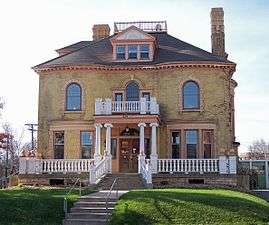William Channing Whitney
William Ellery Channing Whitney[1] (April 11, 1851 – August 23, 1945) was an American architect who practiced in Minneapolis, Minnesota.[2] He specialized primarily in domestic architecture, designing homes for many prominent Twin Cities families.
Biography
Early years
Born in Harvard, Massachusetts, the son of Benjamin F. Whitney, he was educated at Lawrence Academy at Groton, Massachusetts, and Massachusetts Institute of Technology and received his Bachelor of Science from the Massachusetts Agricultural College in 1872. After working in the Boston architectural office of William Ralph Emerson and Carl Fehmer for several years, he moved to Minneapolis in 1878, where he formed an architectural partnership with James C. Plant (1879-1885). In 1885 he began to practice on his own and soon gained a reputation among the manufacturing and milling elite for his residential designs; he built residences for Frank H. Peavey, James S. Bell, William H. Dunwoody, and others. The house he designed in Saint Paul for Horace Hills Irvine in 1911 is now the Minnesota Governor's Residence.
Career
Whitney is credited with introducing neo-Georgian architecture to Minneapolis with his design for the William J. Hinkle House (1886–1887). Within the tasteful exteriors that appealed to his upper-class patrons, Whitney's houses were full of modern innovations, such as central vacuum cleaning plants, electrical refrigeration, and intercom systems. With the reduced household staffing of the post-World War era, his efficient houses retained their value.
During the height of his career he served on the Board of Trustees of the Minneapolis Society of Fine Arts from 1888 to 1896. As a prominent architect of Minneapolis, he was selected to design the Minnesota Building at the 1893 World's Columbian Exposition in Chicago.[3] The structure was built under the impetus of the City Beautiful movement, whose aesthetic was expressed at the exposition's "White City." As a follower of the City Beautiful movement, Whitney was a strong proponent of city parks and ennobling urban schemes.
Whitney continued to practice and trained a younger generation of architects in his office until his retirement in 1925.[4] He was a member of the American Institute of Architects.
Personal life
Whitney married Alma C. Walker on October 6, 1881. The couple had two daughters, Marion (born August 19, 1882) and Katherine (born March 16, 1888).[5]
Selected houses, all in the Minneapolis-St Paul area
- Kate Dunwoody Hall, 1882 or 1883. (demolished)
- Eugene A. Merrill House, 1884. (National Register of Historic Places)
- H. Alden Smith House, 1886. Richardsonian Romanesque (National Register of Historic Places)
- William H. Hinkle House, 1886-1887. Neo-Georgian (National Register of Historic Places)
- Hazen Burton House, 1890. Eastlake Queen Anne
- William G. Northrup Summer House, 1894. Greek Revival (demolished 2013)
- Frank H. Peavey Summer House, 1895. Neo-Georgian (demolished 1953)
- Frank Heffelfinger House, 1902.
- Charles J. Martin House, 1903. Renaissance Revival (National Register of Historic Places)
- William Dunwoody House, 1905. (demolished 1967)
- Elbert L. Carpenter House, 1906. Neo-Georgian (National Register of Historic Places)
- John Lind House, 1907. Neo-Georgian
- James S. Bell Summer House, 1908. Mediterranean Revival
- Horace Hills Irvine House, 1910-1911. English Tudor. Minnesota Governor's Residence since 1965. (National Register of Historic Places)
Other commissions
- Dyer Music Store, 1884
- Minneapolis Club, 1892
- Minnesota Building at the World's Columbian Exposition, Chicago 1893
- Samuel Culbertson Mansion, 1432 South Third Street, Louisville, Kentucky, 1897
- D. R. Moon Memorial Library, E. Fourth Ave, Stanley, Wisconsin, 1901[6]
- Handicraft Guild Building, 1907
Notes
- ↑ Frederick Clifton Pierce, The Descendants of John Whitney, Who Came from London, England, to Watertown, Massachusetts, in 1635. (Chicago) 1895:541-45
- ↑ He was named for the Unitarian minister Dr. William Ellery Channing (1780-1842).
- ↑ The Dream City: Minnesota's Building
- ↑ C.B. Chapman, Adam L. Dorr, and Serenus Colburn, his head draftsman until 1895, are mentioned at Northwest Architectural Archives, University of Minnesota: William Channing Whitney archives website.
- ↑ Pierce 1895.
- ↑ Taylor, Mary E. (August 1985). "D.R. Moon Memorial Library" (PDF). NRHP Inventory-Nomination Form. National Park Service. Retrieved 2016-04-10.
External links
- Heritage Preservation Committee, Minneapolis: William Channing Whitney
- William Channing Whitney collection, N13, Northwest Architectural Archives, University of Minnesota Libraries, Minneapolis, MN.
Gallery
-
H. Alden Smith House in Minneapolis, Minnesota, listed on the National Register of Historic Places.
-

The Hinkle-Murphy House in the Elliot Park neighborhood of Minneapolis, Minnesota
-
Charles J. Martin House in Minneapolis, Minnesota, listed on the National Register of Historic Places.